Development of Stereoscopic Display Technology-Dr. Du Junfan
2020-12-16
Summary
With the development of stereoscopic display technology, more than half of the action movies and cartoons in cinemas are now in 3D format. Although the production of glasses-type 3D TVs is discontinued, the two glasses-type stereoscopic display technologies of polarized and active shutter are still in use. Polarized glasses are used in private home theaters, medical care, education, etc. with their advantages of lightness, thinness, and high brightness. In naked-eye 3D technology, although the small-size products with 2-viewpoint design are no longer on sale, with the improvement of screen resolution, the resin-type lenticular has developed to the super multi view 3D technology with multi-viewpoint design, which is used in electronic whiteboards and digital Signs and other products are used for advertising and exhibition display. We believe that the three-dimensional display technology is still under development and is still not mature enough. The article describes the development of the three-dimensional display technology, explains the principles, advantages and disadvantages of various technologies, and combines the three-dimensional realization Principles, we take stock of existing technologies, whether we can sum up some experience to do in-depth thinking, and plan the problems and research directions to be solved by light field display and holographic display in the future.
The world in the eyes of our human beings is colorful and patchy. The light that spreads into the eyes uses variables such as distance and direction, strength, wavelength, and time to interpret this beautiful world. What the human eye sees is three-dimensional, so how does the three-dimensional sensation form? The human eye obtains a sense of depth in the space by judging the distance and direction of the object's light in the space, under the combined action of psychological and physiological factors; psychological factors are mainly divided into The following six aspects: the size of the image on the retina, the closer the image is to the human eye, the larger the image, and vice versa; some flat images also have a three-dimensional effect, such as long corridors or tree-lined roads. This is because of linear perspective. As the distance increases, the object decreases linearly; overlap also produces a three-dimensional effect. It is considered that the relative position of the occluded object is behind, and the relative position of the occluded object is in the front. Air perspective is often used in image processing, and the nearby scenery is clear and distant. Blurring the scenery will increase the three-dimensional feeling; the use of shadows, such as still life sketches in art, uses dark places to indicate that they are blocked by light to enhance the three-dimensional feeling; the color also affects the three-dimensional feeling. The shorter the wavelength, the farther the color feels. So blue is also called backward color, and red is also called forward color. People can perceive three-dimensional images in flat images because of the above psychological factors.
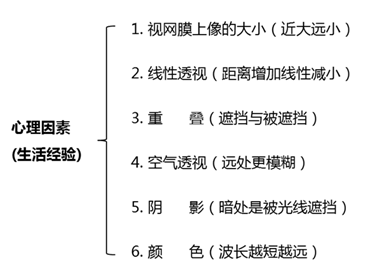
Figure 1. Psychological factors of stereoscopic perception
If people want to perceive stereo, only psychological hints are not enough. Physiologically, they are divided into monocular stereo and binocular stereo. Monocular generates stereo by monocular movement parallax and focus adjustment. Monocular movement parallax refers to the distance when the human eye moves. Objects moving slowly move in the same direction, and objects nearby move fast in the opposite direction; the human eye can adjust the focus of the single eye, and the nerve center uses the ciliary muscle contraction and relaxation information to determine the distance of the object, which is suitable for a range within 10 meters; It is due to the binocular set and binocular parallax. The opening angle of the binocular to the object point is the convergence angle. The smaller the convergence angle, the farther the object is. It is applicable within 20 meters. Binocular parallax is not exactly the same stimulus that the left and right eyes feel. The brain merges into a complete image.
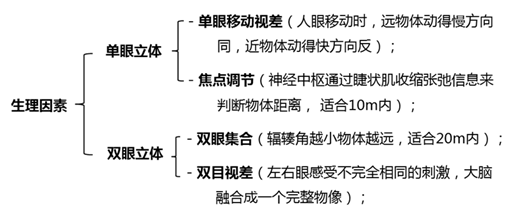
Figure 2. Physiological factors of stereoscopic perception
The real world perceived by the human eye is three-dimensional, while the display devices on the market present a flat surface. Therefore, humans have been studying how to reproduce the real world scene. From the principle of three-dimensional formation, we know that if the light field in the space is formed Real image points, image planes with different depths of field, single-eye focus adjustment and binocular set can make the human eye see the three-dimensional effect. This technology is called true light field display. However, due to the limitations of the display screen resolution and device technology, the technology is still It is immature and cannot meet the product standard; besides, the principle of binocular parallax is relatively easy to achieve a three-dimensional effect. The two eyes receive images with parallax, and the brain merges to form a three-dimensional "phantom" in space. This technology is not a stereoscopic image formed by real image points, but imagined by the brain. The focus adjustment of the human eye is based on the screen, but the binocular set is on the brain fused image, so the monocular focus and the binocular set are inconsistent, and there is a visual contradiction , Dizziness occurs when viewing for a long time, this problem needs true light field technology and holographic technology to solve;
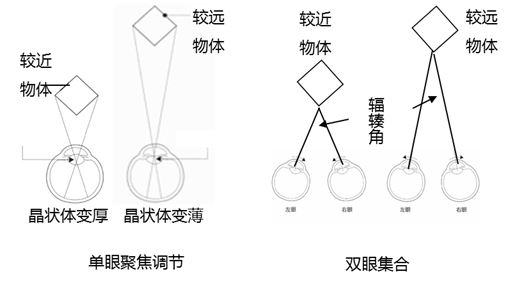
Figure 3. Monocular focus adjustment and binocular aggregation principle of stereo generation
Although there are visual contradictions in binocular parallax technology, the only stereoscopic display technology principle that can be commercialized on the market at present, and it is also constantly developing. Glasses-style 3D are mainly divided into two categories: polarized glasses and active shutter. The market will be in 2011. The upper 30% of the TVs are equipped with 3D function. The polarized glasses type is represented by LG. It has the advantages of light and thin glasses and low cost. The left and right viewing angles are the same as the screen, but the upper and lower viewing angles are very narrow, about 10°. This is because There is a placement height between the odd and even rows of pixels on the screen and the rows of different polarization directions corresponding to the pattern retarder. The higher the placement height, the greater the light crosstalk between the left and right eyes and the smaller the viewing angle. The biggest problem with this technology is that it limits the viewing angle of people. Although polarized glasses-style 3D technology is no longer applied to TV products, it is still the mainstream in 3D theaters, 3D medical, etc. In public theaters, because the film source itself is played separately for the left and right eyes and has different polarization angles, When viewers watch 3D movies, there is no viewing angle problem, but small private home theaters play 3D sources in side by side format, so the 3D device adopts the scheme of pattern retarder attached to the display screen, as is the 3D display in medical treatment. With this scheme, two cameras can capture images in real time at the same time. The captured left and right eye images are displayed on the 3D monitor according to odd and even lines interspersed as a picture. The human eye wears glasses with different polarization directions for the left and right eyes. The right eye and the right eye see different pictures with parallax to form a three-dimensional effect. At this time, the human eye sees a real-time three-dimensional image. At present, LG has basically stopped production of pattern retarder substrate film material and glass. There are still manufacturers in Japan and domestically. The bonding accuracy of Pattern retarder and the screen is gradually improving, and some manufacturers can meet the accuracy of ±3um, and the increase in accuracy can also improve the viewing angle. With the improvement of screen resolution, pattern retarders corresponding to UHD products have been released. The problem of narrow viewing angles at the top and bottom has also been improved by methods such as thinning, but the most ideal way is still to make the pattern retarder in the cell box of the LCD screen. It is closely attached to the color film layer, so that the viewing angle can be greatly improved, but at present, almost no screen manufacturer is developing this technology. Active shutter 3D is the main technology promoted by Samsung before. The display screen is above 120Hz, with liquid crystal shutter glasses, and the principle of persistence of vision between the left and right eyes of humans is used to achieve the stereoscopic effect. The viewing angle is larger than the polarized type, but there is brightness. Low, inconvenient to wear glasses, serious flicker, etc. This technology was previously applied to TV products, but it is currently not widely used.
After glasses-style 3D technology reached a peak in 2011, due to the shortage of 3D film sources, dizziness and other reasons, the technology declined rapidly. People have always been unable to accept glasses to watch TV, so everyone focused on the development of naked-eye stereo display technology. Compared with glasses-type stereoscopic display technology, the biggest advantage of naked-eye 3D display technology is that the glasses are removed, and the biggest disadvantage is that the crosstalk is large and the viewing angle is narrow. Therefore, the core content of naked-eye 3D technology is how to increase the viewing angle.
The naked-eye stereoscopic display technology is mainly divided into two types: slit grating type and lens type. The principle of slit grating is to split light by attaching a grating in the front of the screen to the light-shielding area and the light-transmitting area to achieve the light of the left eye pixel. All the light incident on the left eye, the right eye pixels all incident on the right eye, the left eye pixels display the left eye image, the right eye pixels display the right eye image, there is parallax between the left eye image and the right eye image, so that the human eye will Seeing the three-dimensional effect, this technology has a high degree of conformity with the process of the screen manufacturer. The development of the slit grating has gone through the three generations of fixed grating, liquid crystal grating, and progressive liquid crystal grating (combined with Eye tracking system and image switching). Compared with the fixed grating, the liquid crystal grating can realize the 2D/3D switching function. The progressive liquid crystal grating is composed of many electrode strips. The grating opening can move with the movement of the human eye. The image equipped with the Eye tracking system can also be switched in real time accordingly. Large viewing area. This technology is currently mastered by LCD panel manufacturers in various aspects such as production.
Lens-type glasses-free 3D technology is based on the structure of the cylindrical lens attached to the display screen. According to the degree of difficulty, there are several technologies such as Lenticular, Polarization active lens, Actively Switched Lens, Electric field Driven LC Lens; Lenticular has many columns. The fixed grating composed of lenticular lens, currently mostly uses low-refractive material to fill in the high-refractive material convex lens, placed on the display screen, pixel size, content layout, placement height and lenticular grating parameters match, left and right The eye image can be separated to produce a 3D effect; Polarization active lens uses a TN Cell to control the polarization direction of the emitted light, and polarized light in different directions will be deflected or directed when passing through the birefringent grating, thereby achieving 2D/ 3D switching function; Actively Switched Lens is to replace the resin-type lenticular isotropic material with anisotropic LC material, through the voltage control liquid crystal molecule deflection to achieve the lens effect; Electric field Driven LC Lens is two pieces of ITO glass sandwiched In liquid crystal, different electric field strengths are set in different areas to control the different degree of deflection of liquid crystal molecules to produce a lens effect; among the four technologies mentioned above, the latter three can realize the switching of 2D/3D function, although the resin type Lenticular This function cannot be achieved, but in large-size products that require long-distance viewing, as the screen resolution increases, especially the emergence of 8K screens, the pixel size becomes smaller and the lens aperture becomes smaller. There is no need for 2D switching, and it does not affect When viewing 2D displays at a distance of more than 2 meters, the resin-type Lenticular occupies most of the market share of naked-eye 3D products with low cost. The biggest advantage of Polarization active lens and Actively Switched Lens technology is that it can switch between 2D/3D functions. Among the small-size 3D products, Samsung’s previously released 15.6-inch glasses-free 3D notebook is the application of this technology; the first three technologies are basically mastered by the manufacturers and laminating manufacturers of 3D cylindrical lens films, and the last is Electric field Driven LC Lens technology. , LCD panel manufacturers need to make the liquid crystal lens. Although the current cell cell gap problem is basically solved, the retardation curve is not perfect due to liquid crystal orientation and other reasons. The current liquid crystal lens accuracy is not as good as the resin lens. Commercialized.
Compared with the two naked-eye stereoscopic display technologies of slit grating type and lenticular type, the lenticular type is the current mainstream technology. Most naked-eye 3D products on the market are lenticular type. The slit grating type shields light, At least half of the efficiency is lost, so the brightness is low, the power consumption is high, and the liquid crystal grating double-layer screen is prone to moir. LCD panel manufacturers need to purchase glass to glass high-precision laminating equipment; The 3D transmittance is as high as 90%, so high brightness is the biggest advantage, but the lens type eliminates the moiré by tilting the cylindrical lens and also brings the increase of crosstalk. At present, the two naked eye 3D technologies can not solve the high crosstalk and viewing angle. The minor problem is to increase the viewing angle by sacrificing the resolution to make multiple viewpoints, but it can only weaken the crosstalk and parallax, but still can not completely solve the problem of high crosstalk. Equipped with the Eye tracking system to increase the viewing angle does not achieve commercialization, and The "dead zone" between the main lobe and the side lobe is also a problem that needs to be solved.
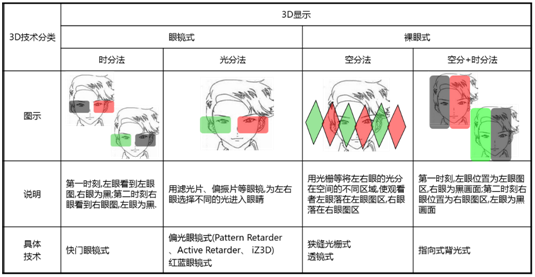
Figure 4. Classification of time and space division of stereoscopic display technology
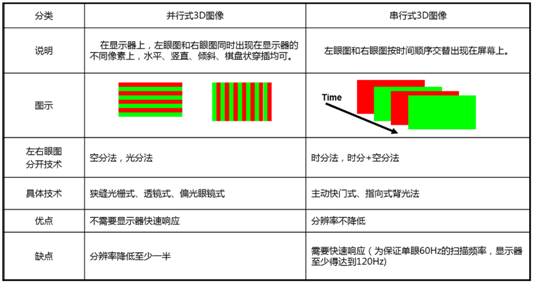
Figure 5. Image Parallel & Serial Classification of Stereo Display Technology
To summarize the main technologies of stereo display, there are two classification methods, one is to separate the left-eye and right-eye images, time division, space division or hybrid; the other is to distinguish according to the type of image, parallel or serial For details, refer to Figure 4 and Figure 5.
Judging from the current level of 3D technology development, there are still many problems, such as dizziness, bulky structure, inconvenient glasses, high crosstalk, narrow viewing angle, etc. These problems need to be solved step by step. However, even if the 3D technology of binocular parallax develops due to The limitations of its own principles cannot solve all of these problems. For example, the super multi view light field technology cannot solve the problem of human vision contradictions, so we need to work together to study the true light field display and holographic display.
references
[1] Hyung-ki Hong, Sung-min Jung, ect,“Autostereoscopic 2D/3D Switching Display Using Electric-Field-Driven LC Lens(ELC Lens)”,SID2008 pp.348
[2] Yi-Pai Huang, Chih-Wei Chen, etc,“High Resolution Autostereoscopic 3D Display with Scanning Multi-Electrode Driving Liquid Crystal(MeD-LC) Lens”,SID2009 DIGEST pp. 336-339
[3] Juyong Park,Dongkyung Nam,etc,”Active Light Field Rendering in Multi-View Display Systems”,SID2012 pp.36
[4] Shinichiro Oka, Tomohiko Naganuma, et al, “High performance Autostereoscopic 2D/3D Switchable Display Using Liquid Crystal Lens”, SID 2013 Digest pp.150-153
[5] Fu-Chan Tsai,Chia-Po Ho, etc, “Efficient multi-view input data format for glasses-free 3D display”, SID 2013
[6] Chuanyuan Pan, Hongqing Cui, et al, “Full screen 3D visual uniformity design for multi-view slant LC Barrier auto stereoscopic display”, IDW/AD 2012, pp 1207-1210
[7] Wang Qionghua. "3D Display Technology and Devices". Science Press. 2011.
